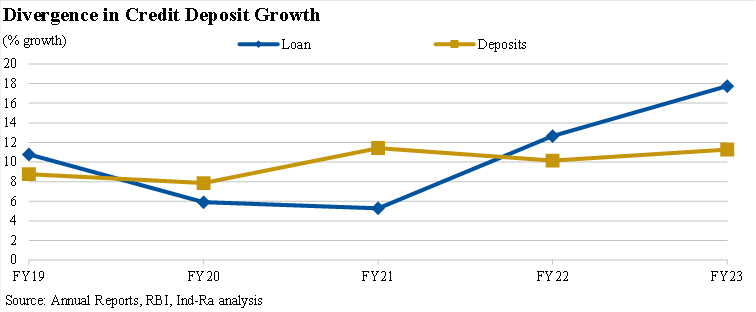BANKS
Bank loan rates to face upward bias in FY24
Despite sudden surge in liquidity, bank deposit rates are unlikely to fall while borrowing costs could continue to face upward bias in FY24, says India Ratings and Research.
Despite sudden surge in liquidity, bank deposit rates are unlikely to fall while borrowing costs could continue to face upward bias in FY24, says India Ratings and Research.

Despite a sudden surge in liquidity, bank deposit rates are unlikely to fall while borrowing costs could continue to face an upward bias in the current financial year.
According to India Ratings and Research, the sudden surge in banking system liquidity is unlikely to push down the system rates as the incremental durable liquidity is not enough to meet the base money requirements for FY24.
Deposit rates would rather stabilise at the current level, especially retail. Lending rates would continue to face an upwards bias in FY24 albeit with moderated intensity, the rating agency said.
Highlighting the heightened risk of tight financial conditions, the agency said that the banking system liquidity in FY24 is a key monitorable aspect.
Sustained tight liquidity conditions could prove onerous for entities with a weak liquidity profile, the agency cautioned in its FY24 Credit Market and Banking sector outlook report.
“Financing conditions are, however, expected to be better in 2H than in 1HFY24, precisely in 4Q,” it said.
The agency does not expect a broad-based weakness in the corporate credit profile owing to the prevailing monetary conditions. However, sustained pressure on operating margins and tight monetary conditions (both cost and availability) could increase refinancing risks for weak entities, it said.
Significant improvement in banking system liquidity
As per the report, liquidity in the banking system has improved meaningfully starting from the second half of May.
“Overall, the net liquidity adjustment facility balance clocked Rs 2.4 trillion in the first week of June as opposed to the average Rs 0.5 trillion in April. The improvement in liquidity has largely been caused by the Reserve Bank of India’s (RBI) dividend transfer (Rs 874 billion) and subsequent spending by the government, an improvement in FPI flows (1QFY24: Rs 817 billion; till 20 June) and withdrawal of Rs 2,000 currency notes,” it said.
The agency expects the surge in liquidity (partly due to base money creation M0) to be adequate for 2QFY24, thus easing financial conditions. This is based on the assumption of moderate-to-neutral net balance of payment surplus/deficit.
Asymmetric liquidity and conservative approach by banks
While the banking system has shown a surge in liquidity on a net basis, all banks are not in surplus. This has reflected in elevated borrowings from the marginal standing facility window.
In addition to that, the muted response in the Variable Rate Reverse Repo (VRRR) auction further showed the banks’ conservative approach. The diverse nature of banks’ behaviour, as reflected in the divergence trend between high surplus liquidity and muted interest in VRRR, is actually the minimal opportunity loss between VRRR (in general average rate of VRRR) of 6.49% and standing deposit facility of 6.25%, in relation to the prevailing uncertainty in the system liquidity, the report added.
Broad-based deposit rate stabilises
Driven by a moderating credit demand and easing liquidity, deposit rates in the banking system have stabilised.
The agency, however, does not see any fall in deposit rates, especially in the retail segment. The reason: banks are still facing challenges because of multiple products in the financial market against long-term, stable deposits.
The merger of HDFC Ltd, India’s largest housing finance company, with HDFC Bank will also necessitate a higher demand for deposits to replace existing liabilities in the books of HFC, it added.
Besides, in an uncertain environment of healthy credit demand and volatile liquidity and rising issuances of certificates of deposits, banks will continue to focus on strengthening their deposit base.
Lending to continue to face upward bias, albeit at a moderate pace
Given the large part of the incremental credit disbursement has been supported by the drawdown of cash flow with the RBI in lieu of Reverse Repo in FY23, the impact of marginal cost of funding has so far been limited.
The rating agency, however, believes that the incremental funding by banks in FY24 would have to be done by way of fresh deposits. The marginal cost of funding will thus go up reasonably.
“Overall, deposit rates in the banking system have shot up by 150 to 200 basis points in the past one year, which has resulted in a 75 basis point increase in aggregate deposits in the system,” it said.
Easing of money market rates
Money market rates have softened in the last fortnight, owing to the significant improvement in banking system liquidity.
The agency expects the overall liquidity to remain supportive in the coming three to four months.
“Rates in the money market will remain soft. However, a significant fall in them is not expected owing to a likely pick-up in issuances,” India Ratings and Research said.
